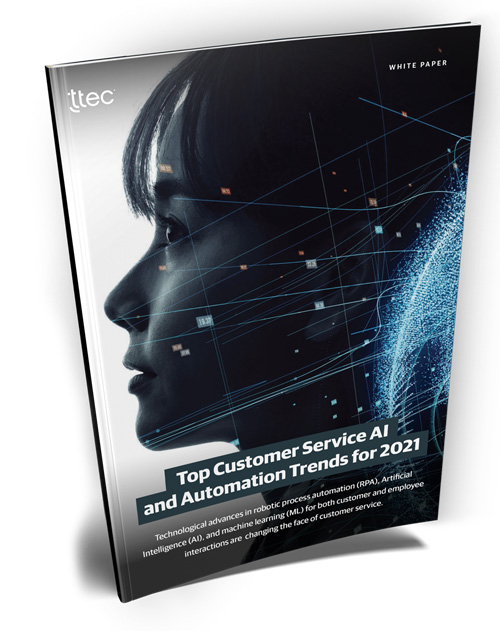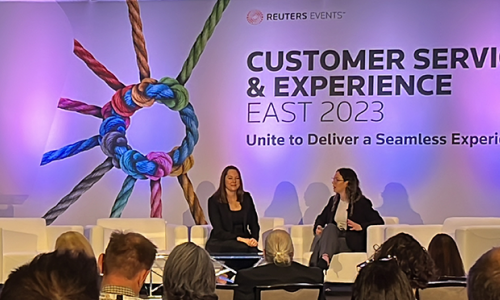Too often, customer experience (CX) projects can’t keep up with the needs of customers. It takes time, budget, and internal political will to develop new technology implementations, robust data analytics insights, and coordinated channels to match the changing technical and customer landscape.
However, these projects are led by IT and may take years to launch, let alone show quick ROI. That’s not fast enough for today’s digital age, where speed is essential and customer experience is the differentiator.
Rather than stick to the old way of doing business, progressive firms are creating innovative, flexible customer experiences at scale and budget with speed. Customer Experience as a Service (CXaaS) is an end-to-end managed services approach that combines CX strategy, technology innovation, data integration, automation, and employee expertise to quickly develop and expand customer-centric initiatives.
Companies across the CX marketplace are forming partnerships to enable a cloud-based suite of CX services based on customer outcomes, not internal effort. We at TTEC and others are working with like-minded brands to offer a flexible approach across the customer journey that removes the burden from IT and focuses attention where it belongs—with business owners in service, sales and marketing.
CXaaS is more than just another technology with “as a service” on the end of it. It is much more than a buzzword. CXaaS is an outcome-based business model reduces the risk from technology investments by replacing giant technology infrastructure with a flexible cloud-based platform. Services can be ramped up or down in near real-time with a mix of optimization, automation, analytics, and continuous improvement. It is the backbone of true digital transformation.
More than a technology refresh, CXaaS enables a foundational and cultural shift to digital, driven by innovation. It reimagines how a customer experience should be thought of, delivered, and paid for. It is not only the backbone, but also the launch pad of true digital transformation around the customer that produces ROI.
With CXaaS, IT aligns with the business and CX partners to continuously make improvements across all facets of the customer experience that build on one another. As gains are realized, cost savings from each incremental improvement gets invested into further optimization. Here’s how it works:
1. Create a CX roadmap to optimize customer interactions
Find quick wins for efficiency and optimization to create a more seamless customer experience with less effort. Unique to each program, examples may include:
- Prioritize customer segments for personalized outreach
- Bots to assist contact center employees
- RPA to automate simple customer and employee tasks
- Mobile messaging as a customer contact option
- Analytics to gather insights for continuous improvement
Each one of these solutions reduces costs and improves efficiency of CX programs. Together, they create an immovable foundation based on data to understand what customers need and how they behave when they interact with a brand. The information generated from these digital optimizations reveals hidden insights to inform even further CX improvements.
2. Act on insights to enhance customer experiences
With insights now in hand, prioritize initiatives to enable customer self-service, automated chatbots and proactive notifications without risking CX quality. These tactics will reduce calls and dependence on human labor while improving customer interactions and further improving the customer experience. Here is where cost to serve can be dramatically lowered by enabling automation and streamlining customer projects based on their propensity to deliver results.
3. Become future-ready across the organization
Building off the prior two phases, expand to other customer-facing business units to activate transformation across customer channels throughout the lifecycle. This phase is more aspirational – what would an ideal customer experience be, and how do we get there? Using an agile model, don’t commit more than 12 months ahead, since customer and business environments rapidly evolve. Common investments include:
- Web & app optimization
- Proactive channel orchestration
- Advanced CX marketing & sales analytics
- Personalization services cloud
A CX as a Service model provides the flexible structure that’s needed in today’s risk-averse business climate to deliver digital transformation and positively impact the entire customer journey without placing a heavy burden on IT or straining budgets beyond what’s already allotted. The time is right to move from the on-premise past to the cloud-enabled CXaaS future.
More CX services resources
We hope you enjoyed this article about Customer Experience as a Service (CXaaS). Here are additional resources from our CX services experts on how to optimize your customer and employee experiences.
Top Customer Service AI and Automation Trends: Automation is a natural fit in the contact center to help create great customer experiences. Many customer interactions are high-volume and repeatable, which can be done in channels like chat, messaging, IVR and others that lend themselves to be easily automated. In this repot, we explore custom support automation trends and how to realize the potential 186% ROI benefit from an automation strategy for resolving customer questions.
Omnichannel Contact Center Digital Transformation Best Practice: A key aspect of successful customer care and digital transformation is to optimize your contact center to measure customer satisfaction and to gain a better understanding of the entire customer journey. In this blog post, we look at how these customer insights can help you provide more personalized experiences when customers interact with your brand, products, and services.
Channel Orchestration: Make Your CX Efforts Sing: Whether phone calls, self-service, social media, live chat, or in-store, successful customer service management requires your company to provide true omnichannel orchestration that aligns the best channels to the right interactions. In this Strategy Guide, our omnichannel consulting team outlines 4 keys to successfully integrate traditional and digital channels to create great customer experiences.
Five Steps to Customer-Centric Digital Transformation: Five Steps to Customer-Centric Digital Transformation: Moving from a channel-centric to customer-centric operating model can feel like a mammoth undertaking. Don't worry! In this White Paper, we'll explain the five key steps to enable end-to-end digital transformation that improves customer satisfaction, reduces cost, and increases revenue.
Understanding the Customer Journey Every Step of the Way: When done well, using customer journey maps to guide CX transformation creates new customer value that can lead to sustained competitive advantage. In this Strategy Guide learn what drives customer engagement, how to better anticipate customer expectations and needs, how to generate new ideas to improve the CX journey, and ways to make the right investments to develop customer-focused cx services.







